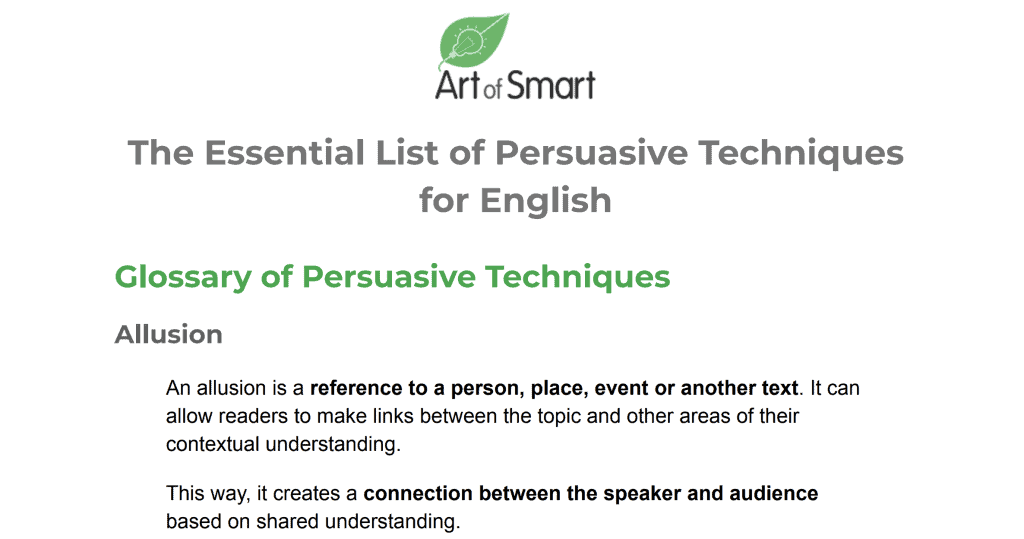What are the key techniques that you should use for a persuasive piece?
There are so many English techniques out there, that it’s hard to keep track of which technique to use when writing a persuasive essay. So, we’re here to help you!
Here is a comprehensive guide on what persuasive techniques are, why these techniques are important as well as the types of persuasive techniques you can use to smash your English assessment!
What are you waiting for?
Let’s dive in!
What Are Persuasive Techniques?
Why Are Persuasive Techniques Used?
Why You Should Use Persuasive Techniques
Types of Persuasive Techniques
Glossary of Persuasive Techniques
Ethos Persuasive Techniques
Pathos Persuasive Techniques
Logos Persuasive Techniques
What Are Persuasive Techniques?
Persuasive techniques are the tools you use to enhance your argument in a persuasive piece. Think of persuasive techniques as the building blocks you use to make your point of view rise above the rest!
These techniques appeal to your audience’s logical thinking and emotions so that they are convinced to agree with a specific viewpoint.
What’s the Difference Between a Persuasive and Argumentative Essay?
An argumentative essay explores two or more perspectives and allows the audience to decide what they can agree with.
On the other hand, persuasive techniques nudge readers to one side of the argument, with counter arguments to undermine the other side.
Check out our ultimate guide to writing persuasive texts here!
Why Persuasive Techniques Are Used in Written and Verbal Communication
The main point of using persuasive techniques is to persuade others to agree with our arguments. These arguments can involve our own ways of thinking, opinions, values and comments on a certain idea, topic or event.
If you look around, you can find persuasive techniques everywhere!
Persuasive techniques can be found in written sources such as newspapers, magazines and feature articles. For example, a newspaper advertisement that promotes its brand new toothbrush definitely uses persuasive techniques to convince you to buy it!
You can also find them used in verbal communication such as speeches, podcasts and media advertisements.
These days, social media platforms such as Youtube, TikTok and Snapchat are the most common places where you can find persuasive techniques in verbal communication.
Think about it, have you ever watched a youtube video where an influencer raves on about a new product? That’s using persuasive techniques too!
How Should You use these Techniques?
Here are some examples of motives to use persuasive techniques, which includes appealing to the audience’s:
- Desire to be an individual
- Desire to belong in a group
- Desire to become wealthy
- Desire to become healthy
Why You Should Use Persuasive Techniques
Mastering the use of persuasive techniques can be a very useful skill!
When it comes to your English assessments, these techniques can amplify the quality of your writing and help you compose better arguments! That’s why it’s so important to master them.
Persuasive techniques are just one way that you can boost your results. Our expert English tutors in the Hills District can help you find other ways to unlock better writing quality – learn more about how they can help!
These techniques can also allow you to influence others to believe in a cause and enact change. For example, a lot of charity campaigns use these techniques to encourage people to donate and make changes for the people, animals or the environment.
For you, persuasive techniques can increase your chances of getting into your dream university course. You can also use these techniques in your future career — to pitch your project, inspire groups of people or build partnerships with world leaders.
As you can see, they can take you beyond the classroom and help you build the effectiveness of your written and verbal communication for success in your career!
Types of Persuasive Techniques
Ethos, Pathos and Logos are the three modes of persuasion. These first coined by Aristotle, an ancient Greek philosopher who observes that these three factors are the core of what makes a great persuasive piece!
For the purposes of this article, we will include four types of techniques. The first one is an “overall” section as these techniques can be applied to either ethos, pathos or logos.
Next, we will dive into the three modes of persuasion as well as their unique techniques.
Let’s jump right into it!
Glossary of Persuasive Techniques
Allusions
An allusion is a reference to a person, place, event or another text. It can allow readers to make links between the topic and other areas of their contextual understanding.
This way, it creates a connection between the speaker and audience based on shared understanding.
Example: “Be a Good Samaritan today and donate to our charities!”
Analogy
An analogy is a figure of speech that compares one thing to another.
Unlike other figurative devices, analogies identifies the similarities between the analogy and reality. This provides another way for your audience to better understand where you are coming from.
It works because the more you understand an idea, the more likely you are to agree with it.
It is important to note that analogies can fall flat if the message is lost. Try to create a clear image and draw clear similarities when using an analogy.
If it is effective, you can use the analogy at the start of your persuasive piece to capture the attention of your audience although this is not a hard and fast rule.
Example: “I like to imagine that the world is a big machine. You know, machines never have any parts. They have the exact number and type of parts they need. So I figure if the entire world is a machine, I have to be here for some reason. And that means you have to be here for some reason, too.” by Brian Selznick, The Invention of Hugo Cabret.
Contrast
Contrast is used to compare between two things. It can draw similarities and differences between two things to allow your audience to understand its relationship better.
Alternatively, it can also create an emphasis on your point or break down complex concepts so your audience can better understand your argument.
Example: You may choose to contrast our approach to world hunger in the past and the present to emphasise that we have made minimal progress in addressing this global issue as of now.
Hyperbole
A hyperbole is an exaggeration to create emphasis for your argument. Although it can sound pretty extreme, it tells your audience that your point is important, immediate or impactful.
It may also be used for humour to build a connection between the speaker and the audience.
Example: An advertisement for Gillette uses the hyperbole “the best a man can get” to encourage their audience of men to buy their products.
Imagery
Imagery uses descriptive language to create a visual image in their audience’s mind to make the message easier to digest and understand.
Once the audience has a mental view of the speaker’s message, it seems more realistic to them and convinces them to side with the speaker.
Imagery can be used throughout the persuasive piece, and is not isolated to one part. However, if you want to reel in your audience, perhaps feature an image at the start or the end of the persuasive piece to pack a punch!
Example: “Imagine a world where our sons and daughters can live in a world of lush greenery, clear blue skies and fresh wind in their face.”
Metaphor
A metaphor is another figure of speech where one thing represents another. Most of the time, metaphors establish the connection between a concrete object and an abstract concept to help audiences better understand your point.
How this works is that metaphors engage the right brain of creativity, which lowers your sense of rational thinking that defends against alternative thought.
This is how metaphors work to persuade people into believing a whole new perspective.
Example: “I have a dream that one day even the state of Mississippi, a state sweltering with the heat of injustice, sweltering with the heat of oppression, will be transformed into an oasis of freedom and justice.” by Martin Luther King’s “I Have a Dream Speech” in 1963.
Simile
Simile belongs in the group of figurative language techniques that also compares one thing to another.
The only difference is, simile uses words “like” and “as” to draw similarities between two things.
Like other figurative devices, similes help the audience better understand your point by allowing them to think about the similarities between two separate objects.
When using a simile, try to use visual cues, relevant topics and avoid cliches to ensure your piece is engaging!
Example: “Rain, somebody said, is like confetti from heaven. So even the heavens are celebrating this morning, joining the rest of us at this wonderful commencement ceremony” – USSC, Justice John Roberts, Cardigan Commencement Address.
Present Tense
Present tense is used to refer to the topic as a present situation.
It creates a sense of urgency among the audience towards the topic of your persuasive piece. This can be used at the end of your piece to drive action within your audiences.
Example: “We must take action to climate change now, to save our future!”
Rule of Three (Tricolon/Tripling)
The rule of three is used to list things out in groups of three to create an accumulative effect so your points are more appealing and memorable to the audience.
It can add a dramatic flair to your persuasive piece too, to compel your readers to agree with your point of view.
Example: “To succeed, we need perseverance, resilience and ambition.”
Repetition
Repetition is the use of the same word or phrase over and over again to reinforce your point.
It can also act as a reminder to your audience about what your main argument is, to allow them to remember it even after they have read or heard your persuasive piece.
Example: In Abraham Lincoln’s Gettysburg Address, the repetition of “the people” in “Government of the people, by the people, and for the people, shall not perish from the earth.” creates emphasis on the role of the public in politics.
Rhetorical Question
A rhetorical question is a question that is posed by the speaker but does not expect an answer from the audience. It prompts the audience to think about the topic, although the answer is often obvious.
This helps to lead the audience to reach a specific conclusion as they consider the topic and oftentimes, accept the author’s answer.
Example: “Do we really want to save our planet?”
Ethos Persuasive Techniques
Ethos is one of the three modes of persuasion.
In Greek, “Ethos” is defined as character and refers to ethics. In other words, ethos refers to the credibility and trustworthiness of the speaker.
Here are a few techniques that appeal to the audience’s trust in the speaker:
Anecdotes
Anecdotes is a short story of an experience. It can be a personal story that has happened to you, or a story that you have heard from someone you know.
Some speakers like to use anecdotes at the start of their persuasive piece, to allow their audiences to relate to them from the get-go. Anecdotes can also be used to underline how real the topic of your persuasive piece is, to build your credibility for your audiences.
Example: In Emma Watson’s HeForShe 2014 campaign speech, she features her own personal experiences of gender stereotypes in “when I was 8 I was confused at being called “bossy”, because I wanted to direct the plays we would put on for our parents — but the boys were not”.
Colloquial Language
Colloquial language is the use of everyday speech.
Hearing formal language may disconnect speakers from their audiences, so easy to understand everyday language works to help the speaker appear approachable, relatable and down to earth which increases the trust of their audiences.
Example: Instead of “it is required that we should engage in action immediately to secure racial equality for all”, we may say “it is up to you and I to make racial equality a reality for all.”
Expert Opinion
The speaker may feature experts in the field to provide an evidence based point of view that supports their argument, making it more credible and trustworthy for the audience.
The expert opinion may be an affirmation of your opinion, an explanation of your point or feature the latest research on your topic. As long as it supports your point, it can strengthen your persuasive piece.
Example: “According to Dr. John Smith at Herrod Hospital, social media has a tremendous impact on youth’s mental health.”
Collaborating with Well-Known People
Persuasive pieces such as media advertisements often collaborate with well-known celebrities and influencers to promote their product.
By having a famous person recommend your product, it encourages people to trust that your product is well above the rest since someone influential is using them exclusively!
Example: Dunkin’ Donuts collaborated with Charli D’Amelio, the TikTok influencer to create and promote a new cold beverage for young people.
Diction
Diction is the careful choice of words or phrases in your persuasive piece.
The words you choose to use can depend on your purpose. Let’s say you want to present a new scientific finding at a TED talk, you would choose to use scientific terms. If you’re motivating an audience of young people, you may use modern slang.
Either way, diction is an important technique to build connection with your audience. When you speak the same language as them, they are more likely to relate to you and side with you too!
Example: When speaking at the United Nations conference, instead of choosing opening phrases such as “what’s up everybody?”, you may choose to use the phrase “good morning to everyone attending today’s conference.”
Pathos Persuasive Techniques
Pathos is the second mode of persuasion which stands for “suffering” and “experience” in Greek.
It makes up part of the word “empathy”, which relates to emotions, beliefs and values. Pathos techniques appeal to the emotional aspect of the audience as it evokes specific feelings towards the message.
Here are some of its techniques:
Adjectives
Adjectives are descriptive words that shape meaning to a topic, idea or opinion.
It prompts the reader to feel a certain way about the message. Try not to overload your adjectives, as your message can become lost in the bombardment of words.
Example: “Our new mouthwatering recipe for roast chicken and its light, creamy sauce is sure to make your family hungry for more!”
Adverbs
Adverbs is a word that adds expression to a verb, an adjective, another adverb and also an entire sentence. Like adjectives, adverbs can sway the audience to feel a specific way.
For verbs, adverbs can describe how an action has occurred. When paired with adjectives, adverbs can add a level of intensity.
Try to avoid using adverbs with adverbs, as it can sound a bit chunky and disrupt the flow of your pieces. Adverbs can also modify an entire sentence with words like generally, accordingly and fortunately.
Example: “Fortunately (sentence adverb), our movement always dedicates (adverb with adjective) itself towards social equality as we have stood loud and proud (adverbs with verb) about our cause.”
Connotations
Connotations are words that are associated with an emotional meaning.
Speakers choose words carefully with the best connotation that suits their message. This way, the audience can sense the tone in your message to encourage them to agree with you.
Example: Instead of using the word “terrorists” to describe people from the Feminist movement, you may choose to use the word “freedom fighter” to paint them in a positive light and encourage others to support the movement too.
Emotive Language
Emotive language involves choosing certain words to evoke a particular emotion from your audiences.
Speakers may use emotive language to help the audience understand how the speaker or character is feeling, forming an emotional bond with their audiences. This can be effective when you need to harness sympathy or empathy from your audiences.
Example: “The poor Polar Bears have nothing but tiny islands of ice to cling onto, as their homes melt around them.”
First Person Narration
In first person narration, the speaker narrates the story from their perspective.
They refer to themselves with “I” and “Me” to make the story appear more personal, which allows the audiences to relate to them and empathise with the speaker more.
Example: “I, myself, am one of the few who have been affected by this issue.”
Inclusive Language
Inclusive language such as “we”, “us” or “our” can unite audiences with the speaker.
It makes the speaker’s message more universal, so audiences feel that they are part of the speaker’s cause. Inclusive language can be especially effective, if you are writing to catch the attention and promote change within a group.
Example: “It is up to us– we must reclaim our freedom!”
Tone
Tone refers to the general vibe of the persuasive piece.
For written persuasive pieces, the tone could be detected through the choice of words and sentence structures. As for verbal persuasive pieces, tone can be set through the speaker’s pace or volume.
Tone is important because it can influence the way the audience feels towards your message.
A persuasive piece can have a formal tone, a humorous tone, a respectful tone or an enthusiastic tone. Be sure to choose which tone you’d like to set your persuasive piece in before you start writing!
Example: For a persuasive piece with a humorous tone, you may choose to use satirical humour, irony or overstatements throughout your piece to appeal to the light hearted emotions of your audiences.
Logos Persuasive Techniques
Last but not least, Logos is the Greek word for “word” or “speech”. For us, logos sound familiar because it is also found in the modern word “logic”. In short, Logos appeals to the logical thinking of our reader by using rational reasoning.
Here are some of its techniques!
Anecdotal evidence
As discussed, anecdotes are the retelling of real life experiences.
It can be used to appeal to the rational thinking of audiences as it provides a true story that acts as evidence to support the credibility of the speaker’s claim.
Example: “I was one of the few who survived the 2005 Hurricane Katrina in New Orleans, and here is my experience.”
Evidence
Evidence refers to true information that are used to build the credibility of one’s argument.
Evidence can include scientific facts, statistics, research findings, graphs and tables. By providing evidence-based arguments that highlight the pros or cons of the topic, it pushes your audience’s rational thought to lean towards your side.
Example: “Due to climate change, more than 1 million species are at risk of extinction across our world.”
Expert Quotes
Expert opinion can be used to influence the rational thinking processes of your audiences.
By inserting a quote from an expert in the field, it not only builds the credibility of your argument, but also appeals to the audience’s decisional thinking to agree with your point.
You may choose to quote from well known professionals, associations or groups to add weight to your argument!
Example: According to Dr. Christopher Austin, a former director of the National Institutes of Health (NIH) Chemical Genomics Center, “Traditional animal testing is expensive, time-consuming, uses a lot of animals and from a scientific perspective the results do not necessarily translate to humans.”
On the hunt for other useful resources?
Check out some of the other Year 11-12 articles we’ve created below:
- The Essential List of Language Features You Should Know for English
- How to Write a TEEL Paragraph for Your English Essay
- Your Kickass Guide to Analysing Visual Texts for HSC English
- How to Elevate Your Essays in English Using the Thesis + 3 Technique
- The Ultimate List of Key Verbs for HSC English
For students in Years 10 and below:
- How to Study for English in Years 7 and 8
- The Essential List of High Modality Words for Persuasive Writing
- The Ultimate Guide to Writing a Feature Article
- How to Write an Extended Response in High School
- The Essential Year 7 and 8 Reading List
- The Ultimate Guide to Writing a Recount in Primary School
Are you looking for some extra help with persuasive techniques?
We have an incredible team of English tutors and mentors!
We can help you master your essay-writing and ace your upcoming assessments with personalised lessons conducted one-on-one in your home or online!
We’ve supported over 8,000 students over the last 11 years, and on average our students score mark improvements of over 20%!
To find out more and get started with an inspirational tutor and mentor, get in touch today or give us a ring on 1300 267 888!
Kate Lynn Law graduated in 2017 with an all rounders HSC award and an ATAR of 97.65. Passionate about mentoring, she enjoys working with high school students to improve their academic, work and life skills in preparation for the HSC and what comes next. An avid blogger, Kate had administered a creative writing page for over 2000 people since 2013, writing to an international audience since her early teenage years.







